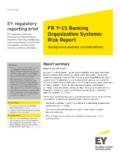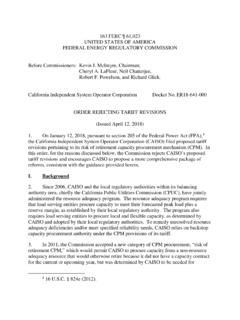Transcription of Real Time In Real Life: The Impact Of A Real-Time …
1 WhitePaper real time IN real LIFE: THE Impact . OF A Real-Time payments system . ON ITS USERS. About real time in real Life . The payments Innovation Alliance, a membership program of NACHA The Electronic payments Association , developed this paper. The goal of this paper is to inform the industry globally on the realities of deploying a Real-Time payments system for users, including a description of the benefits, opportunities and challenges of users utilizing such a system . About the payments Innovation Alliance The payments Innovation Alliance brings together diverse, global stakeholders to support payments innovation, collaboration, and results through discussion, debate, education, networking, and special projects that support the ACH Network and the payments industry worldwide. The Alliance brings together content and focus across all payment areas, including emerging payment technologies, electronic billing and presentment, mobile, payment security/risk, check conversion and global payments .
2 Membership includes organizations of all sizes and spans the payments industry spectrum. About NACHA The Electronic payments Association Since 1974, NACHA The Electronic payments Association has served as trustee of the ACH Network, managing the development, administration and rules for the payment network that universally connects all 12,000 financial institutions in the The Network, which moves money and information directly from one bank account to another, supports more than 90 percent of the total value of all electronic payments in the Through its collaborative, self-governing model, education, and inclusive engagement of ACH Network participants, NACHA facilitates the expansion and diversification of electronic payments , supporting Direct Deposit and Direct Payment via ACH transactions, including ACH credit and debit payments ; recurring and one- time payments ; government, consumer and business transactions; international payments ;. and payments plus payment-related information.
3 Through NACHA's expertise and leadership, the ACH Network is now one of the largest, safest, and most reliable systems in the world, creating value and enabling innovation for all participants. Visit for more information. This paper is intended for educational purposes only. It should not be relied upon for legal advice. Readers should consult attorneys for legal advice. 2 2015 NACHA The Electronic payments Association. All rights reserved. Acknowledgements This paper was developed with the collaboration of many stakeholders. The payments Innovation Alliance would like to acknowledge its members who provided recommendations and expertise during its creation. Neville Arjani Timothy Mills, AAP. Research Lead VP & Executive Director Canadian payments Association The Clearing House payments Association Nell Campbell-Drake, AAP Anita S. Patterson, CTP. Vice President Director, Treasury Services Federal Reserve Bank of Atlanta Cox Enterprises Inc. Jessica L. Cheney, AAP, CTP Matt Pfaltzgraf Director, Product Strategy Solutions Product Manager Bottomline Technologies Inc.
4 SHAZAM Inc. Frank D'Amadeo Nasreen Quibria Director, Treasury Operations Managing Director and Founder Con Edison Q insights Chad Hauff Les Smith Product Development Manager ACH Sales and Business Development Safety Insurance Company Jack Henry & Associates Muneeb Iqbal Shah Dan Thomas Lead Consultant Senior payments Consultant Wipro Ltd. Mindful Insights LLC. Taiji John Kaneda, AAP Jane S. Wallace, AAP. Corporate Product Manager Principal UMB Bank, Wallace Consulting Pam Kennaley, AAP Kristin S. Walle, AAP, CTP. Operations Manager VP, Global Money Movement & Comp. American Express Centurion Bank ADP Inc. Eric Lim Laura Weinflash VP, Online payments VP, Market Strategy Bank Early Warning Services LLC. Leo J. Lipis Edward R. Woods Managing Director Principal Lipis Advisors Mindful Insights LLC. Additionally, the payments Innovation Alliance would like to extend a special thanks to the Lipis Advisors team in Germany, Leo Lipis and Colin Adams, for their significant efforts to develop this white paper.
5 Note: The views presented in this white paper do not necessarily reflect the individual views of each member of the project team, the entities or organizations that employ the members of the project team, the payments Innovation Alliance Leadership Team, or the individual Alliance member organizations. 2015 NACHA The Electronic payments Association. 3. All rights reserved. Executive summary payments system modernization efforts are becoming increasingly common across geographies and these efforts are leading to interest in, development of, and increasing utilization of Real-Time , low-value payments systems. Consumer and business expectations and demand for speed in payments , coupled with evolving payment types, have highlighted a need for faster options for multiple use cases. However, as industry professionals address Real-Time payments , it is evident that real time can mean many different things, with vastly different implications to users of the system . NACHA's payments Innovation Alliance recognizes that, as an industry, we need to further explore and fully understand what a Real-Time system would mean from an end-to-end perspective.
6 The primary focus of this paper is the implications to users of rolling out a Real-Time payments system . An extended discussion of issues such as posting and funds availability and settlement between financial institutions is considered out of scope. While these issues will be touched on briefly to set the context, the focus instead will be on exploring what real time means, outlining the challenges to implementing real time , and focusing on the benefits and opportunities that real time brings. The goal of this Alliance opinion paper is to inform the industry globally on the realities of Real-Time deployment, and explore how businesses, consumers, and financial institutions can implement and utilize a Real-Time payments system in the Through answering these questions, this paper seeks to bring the concept of real time to real life. Defining real time While Real-Time payments systems are proliferating around the globe, there is still no single, universally agreed upon definition of a Real-Time payment.
7 Based upon common characteristics from various global Real-Time payments systems, the payments Innovation Alliance defines a Real-Time payment as an immediate, irrevocable, interbank account-to- account transfer that utilizes a Real-Time messaging system connected to every end- user through a financial institution, third party, or another Real-Time Funds are available for use by the receiver and Real-Time confirmation is provided to both the sender and receiver in seconds. A Real-Time payments system is a synchronous messaging system with request and response capabilities that operates between financial institutions, third parties, gateways and directly connected businesses in real time . Prior to the initiation of payment instructions to the receiver's financial institution or third party, good funds are confirmed, and with this certainty of settlement, there is immediate debiting and crediting of the sender's and receiver's accounts at their respective financial institution/third party.
8 A. proxy database that allows users to make a Real-Time payment without the sender or receiver knowing the other's banking information is assumed, as is the ability to send or receive payments 24/7. 1. his definition does not preclude two customers of the same financial institution serving as sender and T. receiver to the same real time payment transaction. 4 2015 NACHA The Electronic payments Association. All rights reserved. How does real time work? A Real-Time payment has three distinct components: authorization, posting and settlement. Real-Time payments systems must provide authorization and posting of funds in real time , but settlement does not necessarily have to occur in real time . Other important elements include the payment types covered (credits/debits), message flows, messaging standards, and overlay services. Authorization, posting, and settlement Authorization includes both the initiation of payment instructions by the sender, and the Real-Time acceptance by the sending and receiving financial institutions/third parties of the payment request via a Real-Time messaging element.
9 Unlike authorization and posting, settlement between financial institutions/third parties does not have to occur in real time . In fact, the majority of Real-Time systems today utilize a deferred net settlement method. Real-Time gross settlement (where each transaction is settled individually in real time ) has the least risk, but requires high liquidity costs for banks. In contrast, deferred net settlement multiple times a day eases liquidity management, with settlement risk controlled through a range of guarantees (typically through collateralization or pre-funding of settlement obligations). For end-users, settlement between financial institutions is unimportant. The key factors for them are the quick confirmation/rejection notice and the immediate availability of funds. These two factors are what create a Real-Time experience for consumers and businesses. system rules and data standards Issues such as return rights, liability for fraud, and mandated times for posting and/or settlement will be of particular importance in the scheme rules for Real-Time payments .
10 Limiting Real-Time processing to credit ( push ) transactions is a best practice that has been adopted by almost all Real-Time systems today. Credit only transactions offer more security, more protection from fraud, and additional sender control and do not feature the complexity of direct debit transactions, which require mandate management and return rights that would be difficult to provide in a system that offers instant, irrevocable transactions. Nigeria's NIP and Singapore's FAST (G3) systems do have the capability to support both credits and debit-like functionality, but neither these systems, nor any other Real-Time system the Alliance is aware of, currently allows consumers or businesses to initiate Real-Time debit ( pull ) ,3 Instead, the few Real-Time systems that allow payees to initiate debit-like transactions actually offer Real-Time requests for credit or Real-Time requests for debit, with the payer ultimately authorizing the Real-Time payment. The system rules also will need to determine a data standard for the exchange of real - time payment messages, and the rules will need to define how to interpret and utilize specific information in a consistent way for all users.















